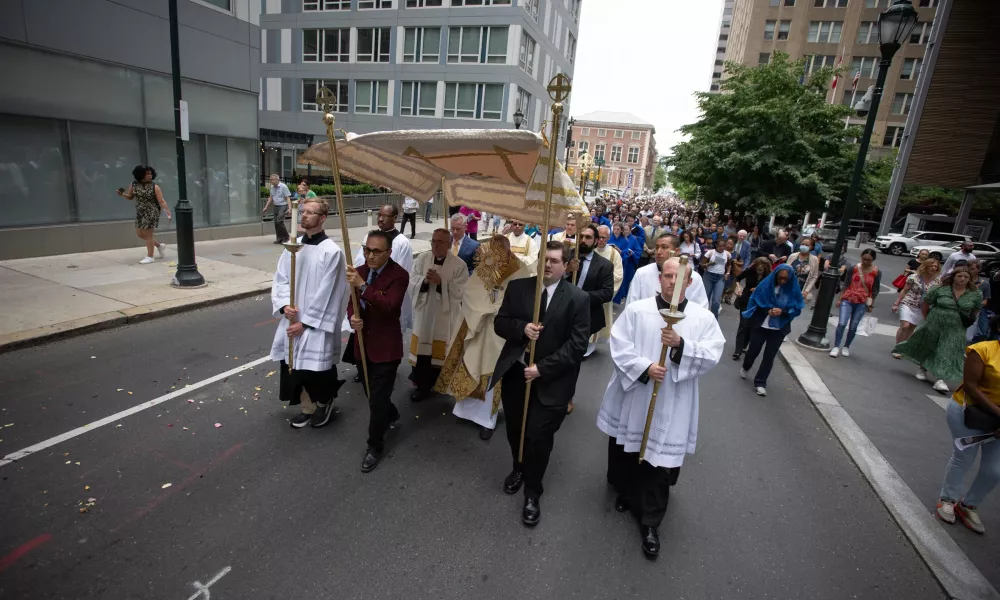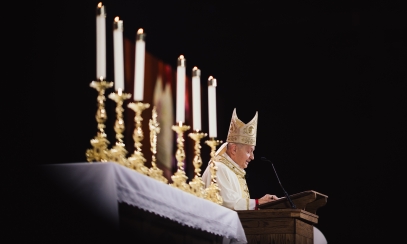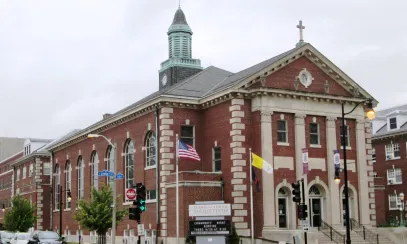
National Eucharistic Pilgrims ‘Relying on God’s Grace’ as They Carry Jesus Hundreds of Miles
Getting your Trinity Audio player ready...
Amid a 17-mile walk through the muggy city streets of New Jersey, Dominic Carstens was understandably tired and a little cranky by his own admission. But then he looked up at the golden monstrance the group was carrying, containing the Eucharist, and his outlook changed.
Amid a 17-mile walk through the muggy city streets of New Jersey, Dominic Carstens was understandably tired and a little cranky by his own admission. But then he looked up at the golden monstrance the group was carrying, containing the Eucharist, and his outlook changed.
Remembering Jesus’ painful trudge to his death on Calvary, “my attitude on what I was doing completely changed,” Carstens, a college student who is walking the eastern Seton Route, said during a June 5 press conference.
“It was a wonderful reminder, with Jesus being present, of what Jesus did for us.”
Carstens is one of the Perpetual Pilgrims accompanying Jesus in the Eucharist for the entire route. Collectively, the young pilgrims — whose ranks have recently swelled to 30 with the addition of several seminarians — will walk more than 6,500 miles over four routes as part of the ongoing National Eucharistic Pilgrimage.
Since the start of the pilgrimages in mid-May, the pilgrims have invited thousands of people, young and old, to join along the way as a public witness to the Church’s teaching that the Eucharist is truly the body of Jesus Christ. The four pilgrimage groups will meet in Indianapolis for the National Eucharistic Congress July 17–21.
As of June 6, the western Serra Route is entering the Denver area; the northern Marian Route caravan will soon exit Minnesota and enter Wisconsin; the Seton Route is nearly to Baltimore; and the southern Juan Diego Route is approaching New Orleans.
Pilgrims who relayed their experiences so far during the June 5 press conference spoke about how they have seen Christ’s presence in the Eucharist affect those who see them pass by.
Carstens recounted how the Seton Route passed through Kensington, an area in Philadelphia known for high prevalence of drug use. During this section, local high school youth helped out the procession by carrying items like candles and canopies, he said, and this and other challenging sections of the route have had the participants “very much relying on God’s grace.” He also said it has been powerful for him to realize that Jesus is “chasing down” so many people who have encountered the pilgrimages directly in the places where they live.
“We got to bring Jesus to the poor, where he really likes to be,” Carstens said. “Christ always loved being with the poor.”
Mason Bailey and Blase Gebes, both seminarians and walkers of the Marian Route, said the experience of seeing “people flocking to Jesus” so far has “enlivened” their vocations and given them ample stories and experiences to use in future homilies if God continues to call them to the priesthood.
“Little things like that can really go a long way in getting men to start thinking about the priesthood again,” Bailey said, commenting on the involvement of many young men from youth groups along the routes.
“There can’t be a Eucharistic revival without also a revival of the priesthood. I think we’re going to see the fruits for years to come.”
Shayla Elm, a Juan Diego Route pilgrim, spoke about the many instances of “childlike” faith she has witnessed. A toddler at one parish kissed her own hand and touched the monstrance when she learned that it was Jesus, Elm recounted. She also said one woman they encountered claims she has been healed of a knee affliction after taking part in the pilgrimage.
Catholics throughout the U.S. are encouraged to register to join the pilgrims in walking short sections of the pilgrimages and joining in numerous other special events put on by their local dioceses.
To read much more ongoing coverage about the National Eucharistic Pilgrimage and National Eucharistic Congress, visit the National Catholic Register.



